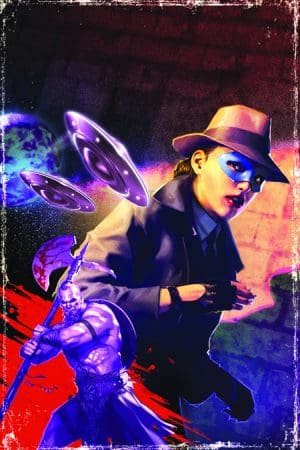
By Paul Kupperberg
I don’t read many anthologies these days. Maybe I should. I’ll usually read those containing one of my stories, like the upcoming Thrilling Adventure Yarns, edited by my friend Bob Greenberger and featuring my short barbarian adventure story, “Dreams of Kingdom,” but it’s been decades since they were regulars in my to-read pile.
I used to read them by the stack when I was kid, back in the 1960s. Science fiction, fantasy, sword and sorcery, mysteries, and even literary anthologies (once I discovered literature). Anthologies are like treasure chests full of every conceivable kind of wealth, no two objects alike. If you don’t like one story, chances are the next one (or the one after that) will be more to your liking.
The first anthology I remember reading was Dangerous Visions, Harlan Ellison’s groundbreaking 1967 collection of state-of-the-art-and-beyond science fiction short stories by the elite of science fiction, past and present, from Isaac Asimov to Robert Zelazny. This 500-plus page tome took the SF community by storm, and it was home to that year’s Hugo Award winners for best novella (“Riders of the Purple Sage” by Philip Jose Farmer) and best novelette, “Gonna Roll the Bones” by Fritz Lieber (which also won the Nebula), and the Nebula Awarded best short story, “Aye, and Gomorrah” by Samuel R. Delany.

I came into possession of Dangerous Visions through the good people at the legendary Science Fiction Book Club, a creation of publisher Doubleday in 1953. It was genre specific “book of the month” club’; members would be sent a mailing offering each month’s book to accept or reject. Send back the postcard to reject it and nothing happen. Accept it—or neglect to mail back the postcard by the deadline, as was most often the case—and the book would be sent, along with a bill. The service’s come-on offer to new customers was something like “eight books for a nickel,” which came with the caveat that they also buy a certain number of books during the year.
I joined the SFBC sometime in 1968 or 1969 and one of my freebies was Dangerous Visions. I don’t have an actual photograph of any of the instances when what I was reading made my head explode, but explode it did. Repeatedly. I had been reading science fiction for a couple of years, lots of Asimov, Heinlein, and Clark, and the stories in DV weren’t anything like I had come to expect. These stories were grown up (I was thirteen or fourteen). I had only recently discovered “New Wave” literature, but this was “New Wave” science fiction. Characters cussed. Had sex. The very first story in the volume, by Lester del Rey, was about man capturing and usurping God; “Evensong” was one of many of the thirty-three stories in that book I’d reread years later and finally, really, understand. These weren’t your talky (but entertaining) Asimov pulp magazine sci-fi tales. This was serious stuff.
But the greatest service DV did me was to introduce me to a slew of new, unfamiliar authors. Brian W. Aldiss, Alfred Bester, Norman Spinrad, Farmer…even editor Harlan Ellison himself, a good chunk of whose oeuvre I went on to devour into my twenties. DV was quite literally my doorway into serious science fiction, the anthology that turned me from a casual reader to a fan.

Fifty years later, I no longer read much science fiction and, except for a few favorite volumes like Clarke’s Childhood’s End, Asimov’s Foundation Trilogy, and a handful of titles by Bester, I no longer keep a lot of it on my shelves. But I still own my half a century old edition of Dangerous Visions, and it’s 1972 follow-up, Again, Dangerous Visions (a third, The Last Dangerous Visions, due originally in 1973, has assumed the status of Bigfoot and the Loch Ness Monster, often believed to have been spotted, but never captured). Both books have been read, repeatedly. I recently lent DV to my son, so he could read it, and, as father used to say to me, “learn what’s what!”
I didn’t know when I ordered it as one of my “eight free books for a nickel” what worlds Dangerous Visions would open up for me. I was already on the road to being a voracious reader, but that one anthology not only fed my hunger, it helped make me a discriminating reader. It inspired me to read other anthologies, science fiction and other genres, and to seek out magazines like New Yorker, Esquire, and Evergreen Review for the cutting edge literary short stories they published. It even gave me the courage to start writing my own “serious” short stories, experimenting with style and subject matter beyond secret agents and superheroes. I didn’t finish ninety percent of them, but at the time, just scribbling even incomplete stories on the lined pages of spiral-bound notebooks was a major victory.
So…I hope you’ll support the Thrilling Adventure Yarns Kickstarter campaign currently underway. Who knows? One day it might just be the anthology that inspires some other young writer to take his pen to paper and create his own thrilling yarns.
